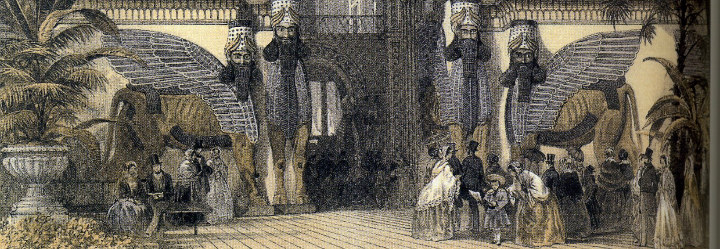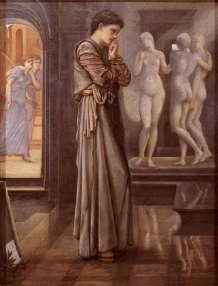Displaying Victorian Sculpture
Displaying Victorian Sculpture
Displaying Victorian Sculpture

Funding: c.£410,000 from the Arts and Humanities Research Council
Duration: Three years from October 2010
Lead investigators: Professor Michael Hatt and Dr Jason Edwards
Collaborators: University of York, University of Warwick and Yale Center for British Art
Contact details:
Displaying Victorian Sculpture, Berrick Saul Building, University of York, Heslington, York, YO10 5DD
About the Project
Displaying Victorian Sculpture
 Displaying Victorian Sculpture is a major, three-year collaborative project, funded by the Arts and Humanities Research Council, that seeks to return sculpture to centre stage in discussions of 19th-century British culture, and to re-assert the importance of sculpture to Victorian history.
Displaying Victorian Sculpture is a major, three-year collaborative project, funded by the Arts and Humanities Research Council, that seeks to return sculpture to centre stage in discussions of 19th-century British culture, and to re-assert the importance of sculpture to Victorian history.
While Victorian Studies has undergone a remarkable growth in the past two decades, with exhaustive research into many aspects of 19th-century British culture, scholars have almost entirely overlooked Victorian sculpture. Displaying Victorian Sculpture seeks to return sculpture to centre stage, and to re-assert the importance of sculpture to Victorian national and imperial history. The project focuses on the display of sculpture in 19th-century Britain and its colonies, in museums and galleries, public spaces inside and out, and in homes from royal palaces to suburban villas.
Addressing a range of objects from cameo brooches through Parianware statuettes to imperial monuments, Displaying Victorian Sculpture aims to reveal the diverse and significant social life of sculpture in 19th-century Britain; a social life both physical, in its weighty presence in public and private spaces around the world; and conceptual, as aesthetic and moral exemplar and as political art par excellence.
The project is led by the departments of History of Art at the University of Warwick and the University of York, with our project partner, the Yale Center for British Art. It will also involve the participation of three regional collections: Kelvingrove Art Gallery and Museum, Glasgow; National Museums, Liverpool; and National Museum, Cardiff. At the heart of the project is a major international exhibition of Victorian sculpture which will open at the Yale Center for British Art in Autumn 2014 and a major London venue thereafter. The project also funds two PhD theses; three annual workshops, in Glasgow, Liverpool and Cardiff respectively; and an edited collection of primary sources on Victorian sculpture.
The project will deliver a range of internationally-significant outcomes which include:
- the first synoptic exhibition of Victorian sculpture anywhere in the world, opening first at the Yale Center for British Art in 2014, then at a significant London venue, with an accompanying catalogue;
- a much-needed collection of Victorian sources on sculpture, researched and edited by the Post-Doctoral Research Fellow at the University of York;
- two PhD theses, co-supervised at the Universities of York and Warwick, the first on the place of sculpture at the great exhibitions; the second on Victoria and Albert’s sculptural patronage. In addition, the project also includes an AHRC funded PhD on sculpture at the Victoria and Albert Museum, and a University of Warwick Postgraduate Research Scholarship funded PhD on Victoria and Albert's daughters and sons as sculptors and patrons of sculpture.
- three colloquia at regional UK museums in Glasgow, Liverpool and Cardiff.
Project Team
Project Team
The project is led by Prof. Michael Hatt at Warwick, and Dr. Jason Edwards at York.
- Prof. Michael Hatt, University of Warwick
- Dr. Jason Edwards, University of York
- Dr. Claire Jones, University of York, Post-Doctoral Research Fellow and project administrator
- Desiree de Chaire, PhD student, Princess Louise’s Sculptural Circle
- Eoin Martin, PhD student, Victoria, Albert and Sculpture
- Gabriel Williams, PhD student, Sculpture and the International Exhibitions
- Charlotte Drew, PhD student, Sculpture at the South Kensington Museum
The steering group for the project comprises:
- Dr. Julius Bryant (Keeper of the V&A's Word and Image Collection)
- Prof. Elizabeth Prettejohn (University of Bristol, Dept of Art History)
- Prof. Amanda Vickery (Queen Mary, University of London, Dept of History)
2012 Symposium
Displaying Victorian Sculpture Symposium
Kings Manor K/111 University of York
13 June 2012, 10.30-5pm
Displaying Victorian Sculpture is a three-year, AHRC-funded collaborative project, led by the universities of Warwick and York, in partnership with the Yale Center for British Art, which seeks to return sculpture to centre stage in discussions of 19th-century British culture, and to re-assert the importance of sculpture to Victorian history. This symposium, hosted by the Sculpture Studies Research School, takes place midway through the project, and presents an opportunity to discuss the research emerging from the project.
10.30 Introductions and coffee
11.00-12.30 The Colour of Sculpture. Chair: Jason Edwards
Michael Hatt (University of Warwick), 'The Colour White: Sculpture and Polychromy in Mid-Victorian Britain'.
Desiree de Chaire (University of Warwick), 'Chryselephantine: Richard Cockle Lucas's Mid Victorian Coloured Ivories'.
Charlotte Drew (University of York), 'Revising the Renaissance: Luca della Robbia at the South Kensington Museum'.
13.30-14.30 Commemoration. Chair: Sarah Turner
Eoin Martin (University of Warwick),' Framing Victoria: Royal Portraiture and Architectural Sculpture in Victorian Britain'.
Jason Edwards (University of York), 'A Monumental Place to Perch: Thomas Woolner's Captain Cook for Sydney'.
15.00-16.00 The Production and Display of Marble. Chair: Michael White
Gabriel Williams (University of York), 'Markets for Polished Marble, c. 1850'.
Claire Jones (University of York),'Variations in Reproduction and Display: Waldo Story's Fallen Angel (1887) and (1889)'.
16.00 Followed by a roundtable discussion
There is no charge for this symposium. Coffee and a buffet lunch will be provided.
If you would like to attend, please contact claire.jones@york.ac.uk
HMI Displays
Displaying Victorian Sculpture Displays at the Henry Moore Institute
The AHRC-funded Displaying Victorian Sculpture project, in collaboration with the Henry Moore Institute for the Study of Sculpture, has initiated a series of Institute Library Displays which highlight the importance of the Institute’s Archive and Library to the study of Victorian sculpture. These demonstrate the variety of ways in which this invaluable resource informs, problematises and inspires research into the practices, display and reception of Victorian sculpture.
Albert Toft: A Lesson in Modelling and Sculpture
24 January 2014 - 23 March 2014
Curated by Charlotte Drew
In 1911, the sculptor Albert Toft (1862-1949) published a teaching manual for his students at the Royal College of Art entitled Modelling and Sculpture. Using photographs, illustrations and diagrams of armatures, half-modelled busts, figures and relief panels, Toft’s book was one of the first of its kind to instruct in the various technical processes of the sculptor’s craft. Modelling and Sculpture gives us a rare, detailed insight into the teaching practices at the Royal College of Art at the turn of the century, as well as a wealth of photographs of the sculptor’s own works in progress.
Toft was initially trained in the Potteries, where, in 1881, he won a scholarship to study under Edouard Lanteri (1848-1917) at the National Art Training School in London. Toft’s own sculptural practice and, in turn, his own teaching methods were heavily influenced by Lanteri’s classes, notes from which were published in 1902 as an illustrated three-volume book, Modelling: A Guide for Teachers and Students.
The practical and physical challenges faced by the sculptor are often overlooked by art historians in favour of a loftier understanding of their work. By focusing on excerpts from Toft and Lanteri’s books, as well as images of Toft working in his studio, this display explores the processes involved in making sculpture – from initial sketch, to modelling in clay and marble carving. It provides a glimpse into sculptors’ training and practice at the turn of the century, highlighting the extent to which sculptors such as Toft had to learn to be anatomists, chemists, engineers and teachers, as well as creative artists.
Richard Westmacott’s Lessons from the Past
21 October 2013 - 22 December 2013
Curated by Gabriel Williams
This display explores how the work of the sculptor Richard Westmacott III, RA (1799-1872) communicated a history of sculpture through his Handbook of Sculpture, Ancient and Modern, published in 1864. The book was based on sketches and notes Westmacott had produced on a study trip to Italy some four decades earlier, in 1820 and seven years after he inherited his father's role as Professor of Sculpture at the Royal Academy. The Handbook set out to educate sculptors through example. Click here to read more.
The Sculptor Prince? Victor Gleichen and the Sculpture Profession in late-Victorian Britain
11 January 2013 - 17 March 2013
Curated by Eoin Martin
Victor Gleichen (1833–91), nephew of Queen Victoria, was a moderately successful sculptor in late-nineteenth-century London. The Henry Moore Institute Archive contains a rare album of photographs showing the contents of the display gallery in his studio in St James’s Palace, London. This material offers an insight into the career of an ‘amateur’ sculptor who used his connections to London’s elite to build a successful professional career. Click here to read more.
Taking Note: William Hamo Thornycroft’s Education Outside the Studio
22 May 2012 - 22 July 2012
Curated by Dr Claire Jones
William Hamo Thornycroft (1850–1925) was born into a family of sculptors, and was immersed in the practice and business of sculpture from an early age. His surviving notebooks, sketchbooks and books, housed in the Henry Moore Institute Archive, reveal how he extended his sculptural education outside this studio environment by visiting exhibitions and museums, attending classes and lectures at the Royal Academy of Arts, and reading widely on sculpture, costume and design. Click here to read more.
Displaying Victorian Sculpture is a three-year collaborative project between the Departments of Art History at the Universities of York and Warwick, funded by the Arts and Humanities Research Council. It seeks to return sculpture to centre stage in discussions of nineteenth-century British culture, and to reassert the importance of sculpture to Victorian history.
The Henry Moore Institute is a world-recognised centre for the study of sculpture in the heart of Leeds. An award-winning exhibitions venue, research centre, library and sculpture archive, the Institute hosts a year-round programme of exhibitions, conferences and lectures, as well as developing research and publications, to expand the understanding and scholarship of historical and contemporary sculpture.
